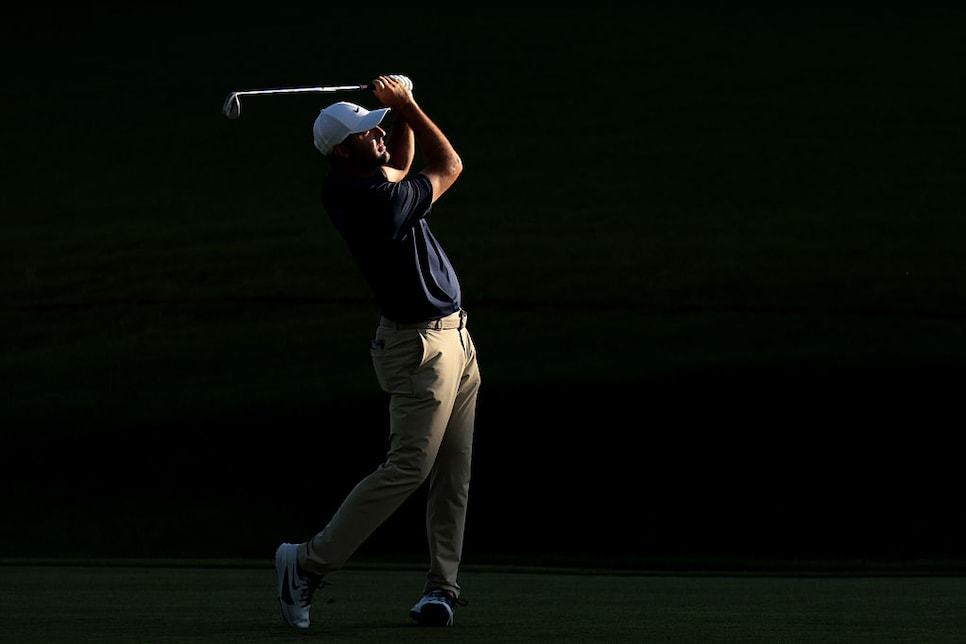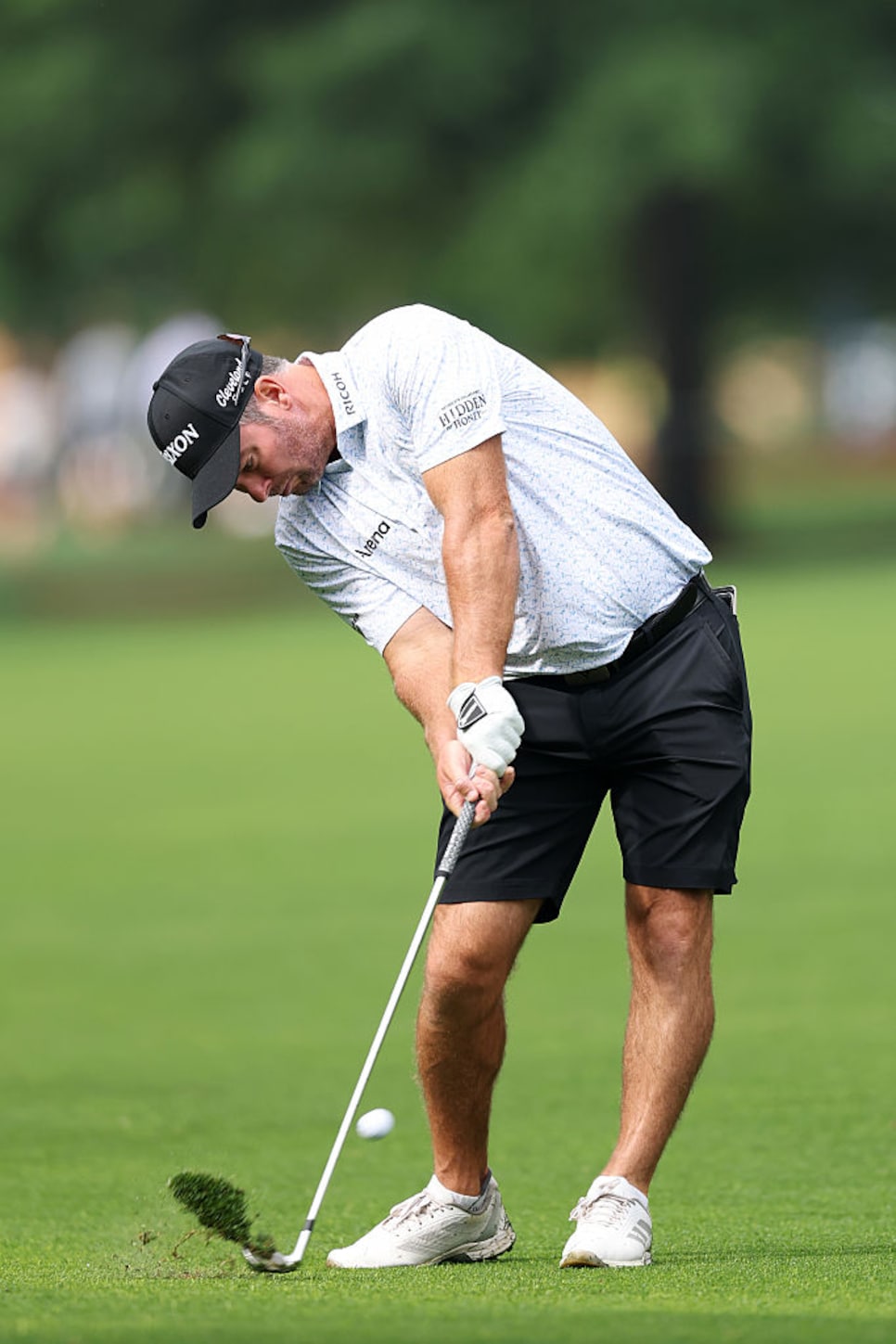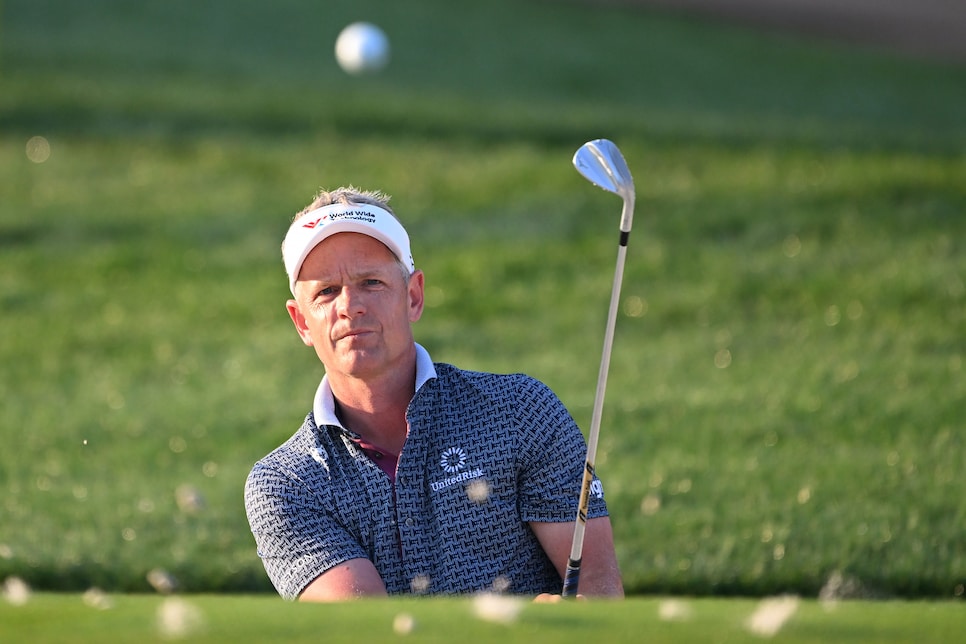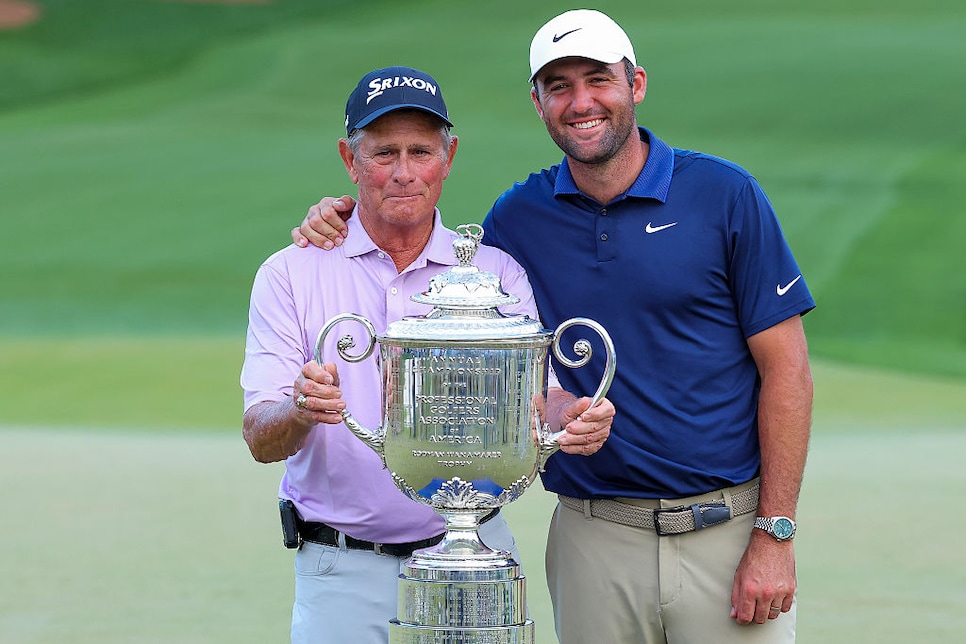CHARLOTTE — Scottie Scheffler has a strange kind of superpower. It’s hard to describe, because I can’t think of any other golfers who have it.
The newly minted PGA Championship winner has this interesting quality where he seems more at ease when he’s leading a tournament. When he’s playing poorly—and by that I mean, somewhere around T-10 rather than winning—he can have a bit of an edge. His temper can flare up. There’s a general air of stewing frustration.
But when Scheffler is playing well, and leading the most prestigious and pressure-packed tournaments, he seems at ease—a kind of relaxed but focused vibe. Playing well and getting into contention gives an air of comfort, as we all witnessed this past week at Quail Hollow.
I know this sounds obvious on one level, but it’s not. Golfers usually act a lot differently when they start playing well—even the very best. Tiger Woods would get locked in, and icy. Rory McIlroy starts bouncing when he walks. Others start withdrawing into themselves and locking up. A lot of us start freaking out. We’re immediately aware of how well we’re doing and start worrying about what could go wrong.
“Pressure is the combination of urgency and uncertainty,” says Dr. Bhrett McCabe, a sports psychologist to numerous tour players and other athletes. “Every one of these guys has led golf tournaments before, but every new situation is novel. When they feel that pressure, they start doing things to solve for that urgency and uncertainty.”

Andrew Redington
Which, again, is what makes Scheffler so interesting.
He seems to feel that dreaded sense of urgency and uncertainty most when he’s not winning. His standards for himself are so high that everything other than excellence is unusual. There were signs of this in his winner’s press conference on Sunday after finishing off his five-shot victory, referring to times in his golf life when he struggled—when “things aren’t going the way they’re supposed to,” were his exact words.
That’s his pressure cooker.
“You’re always battling yourself, and you’re always trying to figure things out,” Scheffler says. “You’re never going to perfect it. I can be kind of a crazy person sometimes trying.”
But then, he returns to form. And when others are feeling the heat, Scheffler moves through with relative ease. Like a pilot manning an airplane mid-flight; a little turbulence is inevitable. But the destination is never in doubt.
“He just gives off a sense of, we’re doing the job we’re meant to be doing,” said Dottie Pepper, as Scheffler striped a drive down the 16th fairway.
Some other lessons from the PGA Championship:
1. You can’t play defense in golf
Heading into the weekend Scheffler faced all sorts of questions about winning the tournament, and all the players around him. Scottie gave a very Scottie response, and I kind of loved it.
“It’s not like other sports because I can’t play defense,” he said. “If I’m thinking about what somebody else is doing out there, that’s not going to be a good thing for me.”
It’s a simple lesson, but a good one. If you’re spending time looking over your shoulder, you’re wasting energy on things that can’t help you. Scheffler was talking about golf, but as it so often is, it’s the same in life. Winners focus on winning.
You can’t get good at golf overnight. Transformative change—discovering the secret—isn’t a thing that actually happens. Whatever your level, getting good at golf means putting yourself on a good trajectory and chipping away.
The idea of making big, radical changes is a mistake even elite players fall into.
“After I won my PGA, I thought, now I really need to practice,” explains 2003 PGA champion Shaun Micheel. “I changed a lot of stuff. I almost felt an obligation to change what I was doing to do something different. I was trying to get better, but it was the worst thing I could’ve done,”
Max Homa alluded to the same thing:
“I wouldn’t advise switching your clubs, your coach and your golf swing at the same time, but I did that,” he says.

Jared C. Tilton
Aaron Rai, who has been on a steady upward trajectory, explained his more methodical, incremental approach.
“What we’ve tried to do as a team is to always try and underline all of the good things that are already there in the first place and keep trying to build and try and build in the easiest way possible through the most minimal amount of change possible and to keep trying to add bits to the game during the season, at the end of the seasons. I think that incrementally over a period of time has amounted to good improvement.”
Incremental progress. Get a little better, every day. It’s not as headline-grabbing as a revelation, but it works.
3. If practice isn’t fun or interesting, it’s probably not helping
Incremental progress means practice, and good practice means not boring practice. It’s something I gained an appreciation for this week asking pros how they design their practice sessions.
Especially Luke Donald. It’s not a coincidence this guy became World No. 1 on the back of his wedges:
“I start at 75 yards. I use three balls, and go back three yards 10 times. So 30 balls total. And then the last 10 golf balls I’ll do random distances between 78 and 91 yards. Then I’ll take all the results and calculate strokes gained from there.”
For the rest of us, it’s probably a little simpler than that. Some kind of game or test that challenges us, and keeps us engaged. Whenever practicing starts feeling like a chore, it’s probably time to get creative.
4. Flaring your feet is a cheat code
When I ask a question at a press conference, it’s usually about something pretty nitty-gritty and golfy. It generally ends in one of two ways: Either I strike out with a bad answer, because the player just isn’t interested in diving into the weeds with me, or I get an unexpectedly good one, because they’ve finally been asked about something they want to talk about.
Asking Ryan Fox about his golf swing on Friday, I thought I was about to get the former.
“I’m definitely not the person to ask that,” he opened.

Warren Little
But then, he saved it! He started talking about why his left foot is so flared out, towards the target.
“It’s a product of having a dodgy left ankle, and that’s why it’s flared out. I’ve had a bunch of cortisone shots in there. I didn’t know if I had that much left in me if my ankle didn’t settle down.”
I found myself thinking about how this can be such a simple solution for so many golfers. If you’ve got weak knees, or tight hips, or a “dodgy” ankle as Fox says, simply flaring that foot out can release a lot of range of motion throughout your lower and upper body. It’s why we instinctively do it when we squat, or walk. And it can help our golf swings just as much.
5. Get aggresive in bunkers
Matt Wallace led the field in Strokes Gained: Around The Greens this week, which included a whopping +4.7 strokes gained from around the greens on Saturday. Wallace holed a bunker shot, and stuck a handful of others to within a foot.
Excited, I ran down to catch him after his round, to learn about whatever bunker witchcraft he had just summoned.
“I’ve always thought I’m pretty good at the standard bunker shots, but the soft, high, short ones that you need in the U.S. I’ve struggled a little bit,” he said. “I’ve got a good idea of how to play them now. I learned you’ve just got to be really aggressive with them. You have to be really aggressive getting the club down into the sand.”
We all have an ideal swing in our minds. For many pros, it’s the pursuit of zero. The idea of hitting dead-straight shots, with a zero club path and a perfectly square, zeroed clubface.
It sounds cool, but it’s really hard to do consistently. Maybe impossible. It can be a dangerous rabbit hole to go down. Most golfers, as Davis Riley explained, are better off embracing a bit of curve.
“It’s easy for us golfers to get obsessive about neutral. I spent a lot of the off-season trying to really straighten out my ball flight, but it was just tough because I came out early in the year and I was aiming really tight to these flags, and then I would kind of make a swing and I bail out. It was just a really awkward spot for me,” he says. “I feel like when I’m playing my best golf I’m seeing about a 5- or 10-yard draw with my irons, and seeing that path around 1.5 to 2.5 degrees [in-to-out]. I got obsessed with being zeroed out and it didn’t really work out for me. Seeing a little draw is in my DNA.”
7. Get greenside in regulation the right way
When Donald popped into contention early on Friday, I decided I had to see how he was doing it.
What I witnessed was probably the best display of scrambling I’ve ever seen.
I asked him how, and yes, hitting good chips and putts was a big part of it. But so was the planning leading up to it.
“When you’re out of position off the tee, that’s when you start thinking about, OK two, three shots ahead: This pin is here; if I can get it to the right side of the green, I’m chipping up the hill. And that’s going to give me an opportunity to get up-and-down,” he explained. “When you’re out of position, you’re really just trying to get to a place where you have a manageable up and down.”

Ross Kinnaird
In pragmatic terms for the rest of us, it means that when you’re in trouble off the tee, advancing your ball to anywhere greenside is a win. And better yet, anything greenside opposite of where the pin is is pretty much as good as it gets.
That’s the Donald formula, and while it won’t ensure an up-and-down every time, it will put you in a position for a good opportunity.
8. A lifting revolution is coming to golf
A few closing thoughts …
I genuinely believe we’re on the verge of another distance jump in golf. Heavy strength training is a given part of the culture in every other mainstream sport. If you want to play football, you’ve got to hit the weights hard. Golf has historically been skeptical and slow to adopt anything to do with lifting heavy weights, but that’s changing. A new wave of smart, next-generation trainers are convincing their players to lift, and lift heavy. Bench; squat; deadlift; a new wave of golfers is coming, and they’re going to be a new kind of athlete.
9. Start your range session with a go-to
I’ve been strangely fascinated recently with how pros start their range sessions. It usually involves some sync-up-your-swing drill.
Three stuck out to me at Quail Hollow:
- Hideki Matsuyama hits one-handed chip shots, with each hand.
- Si Woo Kim places a tee in front of his ball, with the goal of swinging to the right of it.
- Tom Kim hits balls with a slow-motion swing, with his palm open on the grip.
The lesson? Reserve the first balls you hit on the range for a go-to.
10. Don’t freak out
Finally, a closing thought from our 2025 PGA Championship winner on his coach, Randy Smith:
“I wasn’t always the best player. I felt like I could be the best player. But I was a good junior player, a good amateur player, and I did a good job kind of rising up the ranks in professional golf. Randy was always by my side helping me stay patient and teaching me little things along the way. When you’re younger and things aren’t going the way they’re supposed to, Randy always did a really good job of reminding me that it was a long journey to become good at golf.”

Kevin C. Cox
This article was originally published on golfdigest.com

